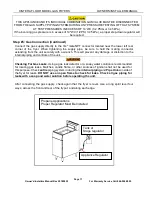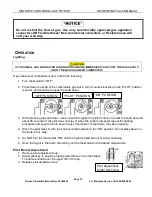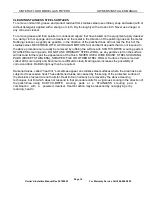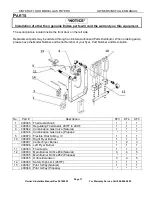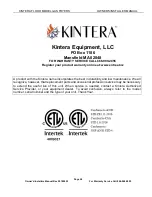
KINTERA FLOOR MODEL GAS FRYERS OWNER’S/INSTALLER MANUAL
Page 10
Owner’s/Installers Manual Rev 20180822 For Warranty Service Call 866-909-2855
The exhaust fan should be installed at least 2 feet above the vent opening at the top of the fryer. Make sure
all ventilation meet local code requirement
This unit is not intended to be connected directly to an outside flue.
Step #5: Gas Connection
A 3/4" male NPT line for the gas connection is located near the lower right rear corner of the fryer. The serial
plate (located inside the front door of the fryer) indicates the type of gas the unit is equipped to burn (natural
gas or propane). The fryer should be connected ONLY to the type of gas for which it is equipped.
A circuit diagram is located inside the front door of the fryer.
All Kintera equipment is adjusted at the factory; however, pilot height should be checked at installation and
adjusted, if necessary.
For orifice sizes and pressure regulator settings, see the chart on page 5. If the fryer is being installed at
over 2,000 feet altitude and that information was not specified when ordered, contact the appropriate
authorized Kintera Service Representative or the Kintera Service Department. Failure to install with proper
orifice sizing will result in poor performance and may void the warranty.
If applicable, the vent line from the gas appliance pressure regulator shall be installed to the outdoors in
accordance with local codes or, in the absence of local codes, with the National Fuel Gas Code, ANSI
Z223.1, Natural Gas Installation Code, CAN/CGA-B149.1, or the Propane Installation Code, CAN/CGA-
B149.2, as applicable.
An adequate gas supply is imperative. Undersized or low pressure lines will restrict the volume of gas
necessary for satisfactory performance. A combination gas valve and pressure regulator, which is provided
with each unit, is set to maintain a 4" W.C. manifold pressure for natural gas or 10.0" W.C. manifold
pressure for propane gas. However, to maintain these conditions the pressure on the supply line, when all
units are operating simultaneously, should not drop below 7" W.C. for natural gas or 11" W.C. for propane
gas. Fluctuations of more than 25% on natural gas or 10% on propane gas will create problems and affect
burner operating characteristics. A 1/8" tap to measure the manifold pressure is located on the combination
gas valve and on the burner manifold, which is on the burner manifold located directly below the burners
inside the cabinet.
Purge the supply line to clean out dust, dirt, or other foreign matter before connecting the line to the unit.
It is recommended that an individual manual shutoff valve be installed in the gas supply line to the unit.
Use pipe joint compound that is suitable for use with both natural and LP gas on all threaded connections.
ALL PIPE JOINTS AND CONNECTIONS MUST BE TESTED THOROUGHLY FOR GAS LEAKS. USE
ONLY SOAPY WATER FOR TESTING ON ALL GASES. NEVER USE AN OPEN FLAME TO CHECK
FOR GAS LEAKS. ALL CONNECTIONS MUST BE CHECKED FOR LEAKS AFTER THE UNIT HAS
BEEN PUT INTO OPERATION.
TEST PRESSURE SHOULD NOT EXCEED 12" W.C.











